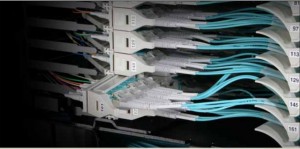Broadcast facilities operate at very high levels of reliability and demand design flexibility to easy accommodate frequent adds and changes to equipment. Managing thousands of cables, should always be a high priority for the network engineer – particularly for maximizing system performance and uptime.
FiberStore plug-and-play solutions are designed to address the reliability, scalability, and thermal needs of today’s mission-critical master control. These solutions promote increased reliability of broadcast centers through properly managed and scalable cable density, which encourages proper airflow and reduces overall installation and maintenance costs.
FiberStore latest introduced optical distribution frame with plug-and-play (MPO) cassettes is the highest density optical distribution frame solution available today. It efficiently manages up to 1,728 fiber terminations using the 144-position block in a single frame in either a cross-connector or inter-connection design. It incorporates the fundamentals of cable management while using the industry’s highest fiber counts MPO plug-and-play cassettes.
One of the most common questions regarding MPO deployments is how the system design addresses the polarity issue of the fiber. Plug-and-play trunks use a key up/key down fiber array. The plug-and-play cassettes are wired straight through. In addition, duplex jumpers have a duplex clip that is easily removed for polarity changes in the field.
MPO Trunk Cables
FiberStore plug-and-play trunk assembles are round 12 fiber optical trunk cables pre-terminated with a high-density MPO fiber connector on both ends. They can be used in conjunction with any of the other plug-and-play connectivity products to rapidly deploy fiber into a broadcast center. The Microcable assemblies can simply be plugged into any plug-and-play cassette in the optical distribution frame or fiber enclosure which eliminates the need for on-site fiber termination and preparation.
High Fiber Count Trunk Cables
FiberStore high fiber count plug-and-play trunks provide the backbone cabling for a plug-and-play system. These high count trunk cables come pre-terminated with a high-density MPO connectors on both ends and provide an easy and efficient way to pull large numbers of fibers at one time to help in the rapid deployment of a plug-and-play system. Each trunk has custom breakouts designed to work with the TE plug-and-play connectivity. High count trunks can simply be plugged into any plug-and-play cassette in the optical distribution frame or fiber enclosure which eliminates the need for on-site fiber termination and preparation.
MPO Hybrid Harness Cables
FiberStore 12 fibres plug-and-play hybrid harness cables provide a convenient and efficient method to connect active equipment into the network. These 12 fiber round 3mm cables contain a pre-terminated high density MPO pinned connector on one end and either LC or SC connectors o the other. The 12 fiber plug-and-play array cables assemblies can simply be plugged into any plug-and-play cassette in the optical distribution frame or fiber enclosure which eliminates the need for on-site fiber termination and preparation.
For assistance customizing your MPO plug-and-play solutions, please email to sales@fs.com

